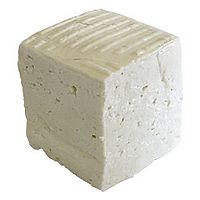Telemea facts for kids
Quick facts for kids Telemea |
|
|---|---|
 |
|
| Country of origin | Romania |
| Source of milk | Sheep, cow |
| Pasteurised | Traditionally, no |
| Texture | soft, semi-soft, brined and creamy |
| Certification | Protected designation of origin, Protected geographical indication |
| Named after | Lua error in Module:Wikidata at line 70: attempt to index field 'wikibase' (a nil value). |
Telemea (pronounced "teh-leh-MEH-ah") is a popular type of cheese from Romania. It was traditionally made using milk from sheep. Today, you can also find Telemea made from cow's milk. Sometimes, it's even made from goat's or buffalo's milk!
What is Telemea Cheese Like?
Telemea cheese is similar to feta from Greece. It's also like other white cheeses found in countries like Bulgaria and Serbia. Telemea can be soft or semi-soft. It has a creamy feel and a slightly tangy taste.
Some Telemea cheese has more water in it, making it very soft. Other types are aged longer. This aging process makes the cheese firmer, saltier, and full of flavor. Sometimes, people add Cumin seeds to Telemea. This gives it a spicy, nutty taste.
You can enjoy Telemea cheese in many ways. It's great as a snack or in salads. People also use it in different dishes, like omelettes, crepes, and pies.
How Telemea Cheese is Made
Making Telemea cheese starts with milk. A special ingredient called rennet is added to the milk. Rennet helps the milk thicken and separate into solid clumps. These clumps are called curds.
Most often, cow's or sheep's milk is used. Goat's and buffalo's milk make a more special kind of Telemea. Once the curds form, they are carefully removed. The curds are then placed in a cheesecloth. They are pressed overnight to remove extra liquid. After pressing, the cheese is cut into square pieces.
Next, the cheese is left to mature in salty water, called brine. Fresh Telemea, kept in brine for a few weeks, is sometimes called caș. For longer storage, the cheese is kept in wooden barrels called putini. If it's stored in a very salty brine, it's soaked in fresh water before eating. This makes it less salty.
Special Types of Telemea
Since 2004, efforts have been made to protect Telemea cheese. This means giving it a special label in the EU. These labels ensure that only cheese made in a specific way or place can be called Telemea. This helps keep the cheese's traditional quality.
There are different types of Telemea named after the areas they come from:
- Telemea de Argeș
- Telemea de Brașov
- Telemea de Carei
- Telemea de Harghita
- Telemea de Huedin
- Telemea de Ibănești (This one has a special label called PDO)
- Telemea de Nucet
- Telemea de Oaş
- Telemea de Sibiu (This one has a special label called PGI)
- Telemea de Vâlcea
In 2017, the EU officially recognized Telemea de Ibănești. It received the Protected Designation of Origin (PDO) label. This means it must come from a specific place and be made in a certain way. Then, in 2019, Telemea de Sibiu received the Protected Geographical Indication (PGI) label. This means it has a link to its geographical area.
See also
 In Spanish: Telemea para niños
In Spanish: Telemea para niños

